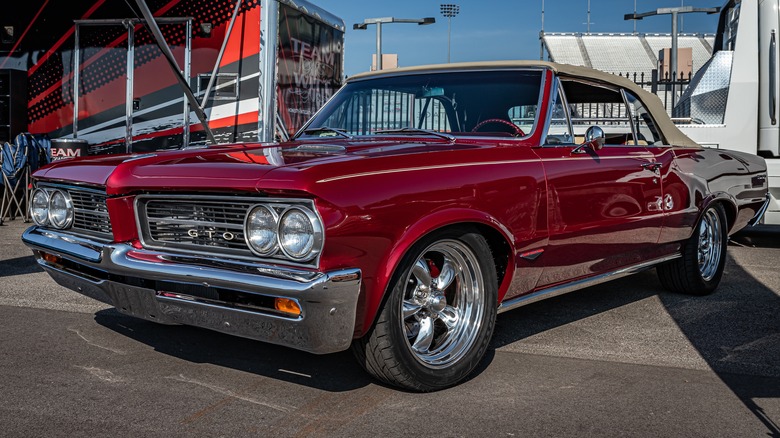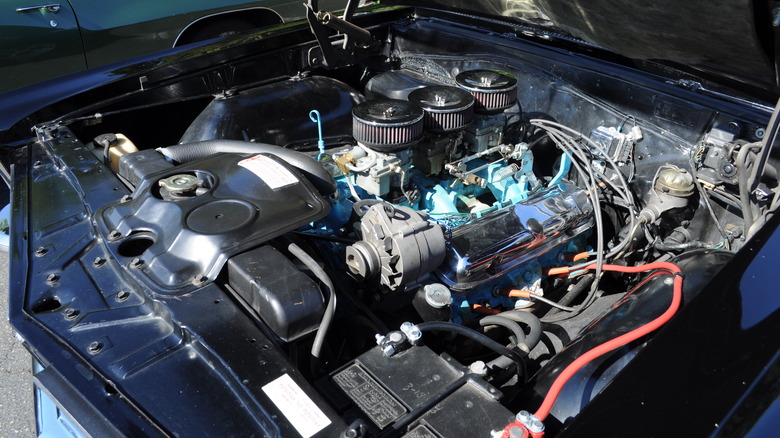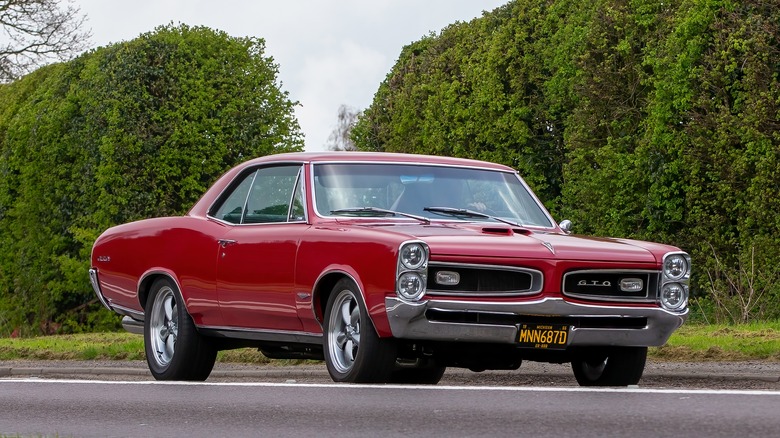Everything Pontiac Fans Should Know About The 389 Engine
The Pontiac brand was established in 1926 by General Motors and was so successful in its early years that GM abandoned its similar Oakland division in 1933. Pontiac had begun to flounder by mid-century, though, so John DeLorean was hired to manage the division in 1956. Pontiac flourished under his leadership, cementing its place in muscle car history with the 1964 GTO and following that up with the beastly yet gorgeous 1967 Firebird.
A big part of the GTO's success was its 389 cubic-inch V8, which had to be snuck into the car due to the Automobile Manufacturer's Association ban on high-performance development after fatal crashes in 1956 at the Indy 500 and 24 Hours of LeMans. DeLorean and his team got around GM's internal limit of one cubic inch of displacement for every 10 pounds of vehicle weight by offering the 389 as an option over the standard 330 cubic-inch V8 for the 3,470-pound GTO.
The base carburetor on the GTO's 389 was a Carter four-barrel that gave the engine impressive output numbers of 325 horsepower and 428 pound-feet of torque. DeLorean knew, though, that some buyers would want more out of their 389s. Three Rochester two-barrel carbs made up a "tri-power" option that boosted output to 358 horsepower and lifted the torque peak from 3,200 to 3,600 rpm.
Every 1960 Pontiac had a 389
Although the 389 and the tri-power setup shown above made the GTO a legend, the engine and tri-power option had been in Pontiac's lineup since 1959, when Pontiac increased the stroke of the 370 V8 from 3 and 9/16 inches to 3 and 3/4 inches. The 389 was offered that year with several different carburetor setups: an assortment of two-barrels, two different four-barrels, and the tri-power. In 1960, every one of the 370,701 cars Pontiac made got a variant of the 389 cubic-inch V8. The brand's lineup that year was made up of just four models: the Catalina, Ventura, Bonneville, and Star Chief. The Tempest, which DeLorean optioned into the GTO, was not produced until 1961.
Although the Tempest label wasn't used as a model name until then, Pontiac put early high-performance versions of the 389 on the option sheet with Tempest and Super Duty package designations. These add-ons featured forged crankshafts and connecting rods along with solid lifters. 1960 versions of the 389 produced between 215 and 425 horsepower, depending on the fuel delivery setup. The Super Duty 389 was dominant on the racetrack, winning 30 out of 54 NASCAR Grand National races in 1960 and '61.
[Featured image by Joe Mabel via Wikimedia Commons|Cropped and scaled|CC-By 3.0]
The 389 lasted through 1966
The 389's racing success led Pontiac to begin advertising it as the "Trophy-8" starting in 1961. That year, it was split in half to make the 194 cubic-inch I4 that went in the Tempest with the label "Trophy-4." Tempest buyers could also get a 215 cubic-inch Buick V8, and a 421-inch V8 arrived in late 1961. The larger engine began to overtake the 389 in terms of output, but that motor was too heavy for the GTO, so Pontiac beefed up the 389 once again in 1964.
The 389 hung around for two more years under the hoods of the GTO, Star Chief, Bonneville, Catalina, Ventura, and Grand Prix. During its eight-year run, the 389 was issued in 13 different configurations with various carburetor setups and valve sizings. Its bore was increased to 4.12 inches in 1967 to make a 400 cubic-inch V8, and the 389-inch format was parked for good.


